Fig. 1.

Genetic correlation analysis. A genetic correlation analysis examines whether the heritable variability in two traits (or phenotypes) is due to the same underlying genetic mechanisms. Inbred strains of mice or rats are tested for their responsiveness or sensitivity to determine the strain distribution pattern (SDP) of means for the traits. Pearson’s correlation coefficient or a Spearman rank correlation is then calculated between the means of each trait. If the SDPs are similar and a sufficient number of strains have been tested, the traits are “genetically correlated”, and the correlation can be ascribed to common genetic mechanisms. The figure demonstrates the logic behind this inference. Fully inbred strains have alleles forced into homozygosity throughout the genome as demonstrated in the figure (e.g., AA). Pain traits are considered to be polygenic with several genes contributing to increases or decreases of the traits. For this example, we will assume that the capital letter alleles of A and B genes contribute to increases in traits I and II, but not trait III, and C and D genes contribute positively to trait III, but not to traits I and II. Phenotyping the mice produces similar SDPs for traits I and II. Since trait III is mediated by different genes, C and D, the SDP for the same strains is different from those of traits I and II. By adding up the gene effects for each contributing gene, one can see the relationship between genotype of each inbred strain and the phenotype value (e.g., strain 2 has two positively contributing alleles to traits I and II). Therefore, even prior to determining the precise mechanisms of heritability, one can make the inference regarding shared genetic mechanisms based on similar SDPs for two or more traits. Note that use of this method requires a significant number of inbred strains (preferred minimum of 11; absolute minimum of 8) be simultaneously phenotyped, and environmental factors must be strictly controlled throughout the experiment
